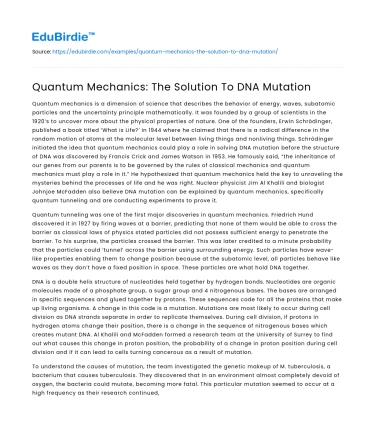Quantum mechanics is a dimension of science that describes the behavior of energy, waves, subatomic particles and the uncertainty principle mathematically. It was founded by a group of scientists in the 1920’s to uncover more about the physical properties of nature. One of the founders, Erwin Schrödinger, published a book titled ‘What is Life?’ in 1944 where he claimed that there is a radical difference in the random motion of atoms at the molecular level between living things and nonliving things. Schrödinger initiated the idea that quantum mechanics could play a role in solving DNA mutation before the structure of DNA was discovered by Francis Crick and James Watson in 1953. He famously said, “the inheritance of our genes from our parents is to be governed by the rules of classical mechanics and quantum mechanics must play a role in it.” He hypothesized that quantum mechanics held the key to unraveling the mysteries behind the processes of life and he was right. Nuclear physicist Jim Al Khalili and biologist Johnjoe McFadden also believe DNA mutation can be explained by quantum mechanics, specifically quantum tunneling and are conducting experiments to prove it.
Quantum tunneling was one of the first major discoveries in quantum mechanics. Friedrich Hund discovered it in 1927 by firing waves at a barrier, predicting that none of them would be able to cross the barrier as classical laws of physics stated particles did not possess sufficient energy to penetrate the barrier. To his surprise, the particles crossed the barrier. This was later credited to a minute probability that the particles could ‘tunnel’ across the barrier using surrounding energy. Such particles have wave-like properties enabling them to change position because at the subatomic level, all particles behave like waves as they don’t have a fixed position in space. These particles are what hold DNA together.
Save your time!
We can take care of your essay
- Proper editing and formatting
- Free revision, title page, and bibliography
- Flexible prices and money-back guarantee
DNA is a double helix structure of nucleotides held together by hydrogen bonds. Nucleotides are organic molecules made of a phosphate group, a sugar group and 4 nitrogenous bases. The bases are arranged in specific sequences and glued together by protons. These sequences code for all the proteins that make up living organisms. A change in this code is a mutation. Mutations are most likely to occur during cell division as DNA strands separate in order to replicate themselves. During cell division, if protons in hydrogen atoms change their position, there is a change in the sequence of nitrogenous bases which creates mutant DNA. Al Khalili and McFadden formed a research team at the University of Surrey to find out what causes this change in proton position, the probability of a change in proton position during cell division and if it can lead to cells turning cancerous as a result of mutation.
To understand the causes of mutation, the team investigated the genetic makeup of M. tuberculosis, a bacterium that causes tuberculosis. They discovered that in an environment almost completely devoid of oxygen, the bacteria could mutate, becoming more fatal. This particular mutation seemed to occur at a high frequency as their research continued, defying part of Charles Darwin’s evolution theory which states that although mutations were necessary to increase genetic variation, they should be random and no mutation should be more frequent than another. The experiment concluded that a change in environment could trigger random and frequent mutations.
The next phase in the team’s research is to understand how the mass of hydrogen atoms affect mutations. They intend to do this by comparing behaviors of normal and modified DNA where all hydrogen atoms are be replaced by deuterium (heavier isotope of hydrogen) atoms. They hypothesize that if protons in hydrogen atoms tunnel to positions outside the DNA sequence, the probability and the rate of mutations will be lower in modified DNA as compared to normal DNA because deuterium atoms are heavier and less likely to change position in modified DNA by quantum tunneling. However, it is expected to take years to design and conduct these experiments.
Although research into DNA mutation is still in its infancy, its potential is obvious. Scientists are optimistic that when the specific nature genetic mutation is uncovered, all forms of cancer and genetic disorders can be eradicated once and for all. It’s only a matter of time before the mystery is unveiled.






 Stuck on your essay?
Stuck on your essay?

